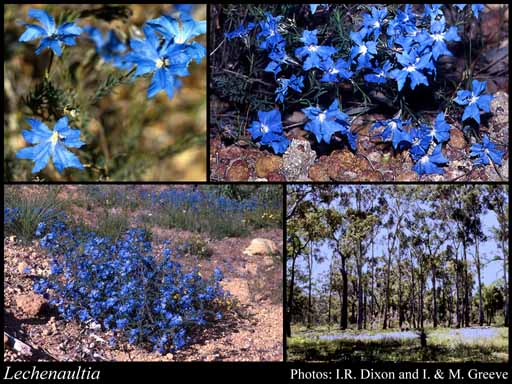- Reference
- Prodr.Fl.Nov.Holland. 581 (1810)
- Name Status
- Current

Scientific Description
Common name. Leschenaultias. Family Goodeniaceae.
Habit and leaf form. Trees (small), or shrubs (undershrubs), or herbs. ‘Normal’ plants, or switch-plants. Leaves well developed, or much reduced (sometimes reduced to scales). Perennial. Leaves cauline. Plants with a basal concentration of leaves, or with neither basal nor terminal concentrations of leaves. Stem internodes solid (ass.). Mesophytic, or xerophytic. Leaves alternate (crowded and heath-like); spiral; sessile; non-sheathing; simple; epulvinate. Leaf blades entire; flat, or rolled, or solid; terete, or semi-terete, or solid/angular; ovate (to narrowly lanceolate), or linear (or narrowly linear); pinnately veined. Leaves without stipules. Leaf blade margins entire. Leaves without a persistent basal meristem. Leaf anatomy. Hairs present, or absent (usually); glandular hairs absent, or present; complex hairs present, or absent. Extra-floral nectaries absent (ass.). Stem anatomy. Secondary thickening absent, or developing from a conventional cambial ring.
Reproductive type, pollination. Fertile flowers hermaphrodite. Unisexual flowers absent. Plants hermaphrodite. Entomophilous. Pollination mechanism conspicuously specialized (involving a stylar modification for pollen presentation).
Inflorescence and flower features. Flowers solitary, or aggregated in ‘inflorescences’; terminal, or axillary (or leaf opposed); in cymes, or in spikes (leafy), or in corymbs (leafy). The terminal inflorescence unit cymose, or racemose. Inflorescences terminal; corymbs compact. Flowers pedicellate to sessile; bracteate (opposite, leaf-like, rarely reduced); bracteolate (leaf-like, rarely reduced); small to medium-sized; very irregular. The floral asymmetry involving the perianth and involving the androecium. Flowers 5 merous; cyclic; tetracyclic. Free hypanthium absent. Perianth with distinct calyx and corolla; (8–)10; 2 -whorled; isomerous, or anisomerous. Calyx present; 5; 1 -whorled; gamosepalous; blunt-lobed; tubular. Calyx lobes narrowly oblong, or ovate, or linear. Corolla present; 5 (unequal); 1 -whorled; gamopetalous; lobed. Corolla tube adaxially deeply split. Corolla valvate; regular (usually, the lobes separated at about the same level), or unequal but not bilabiate (the two upper lobes separated slightly lower); hairy abaxially; hairy adaxially (sparsely so, to densely woolly); green (greenish), or white, or yellow, or red, or blue (or mauve). Corolla lobes ovate. Androecial members definite in number. Androecium 5. Androecial members free of the perianth, or adnate; all equal (ass.); free of one another (rarely), or coherent; 1 -whorled. Androecium exclusively of fertile stamens. Stamens 5. Staminal insertion near the base of the corolla tube. Stamens all more or less similar in shape (ass.); isomerous with the perianth; oppositisepalous (at the base of the corolla); all alternating with the corolla members. Anthers separate from one another (rarely), or cohering; basifixed; dehiscing via longitudinal slits; introrse; tetrasporangiate. Pollen shed in aggregates; in tetrads. Gynoecium 2 carpelled. The pistil 2 celled. Gynoecium syncarpous; synstylovarious to eu-syncarpous; inferior. Ovary plurilocular; 2 locular. Gynoecium stylate. Styles 1; bearing an ‘indusium’ beneath the stigma. Indusium two-lipped. Styles apical. Stigmas 1; 2 - lobed. Placentation axile. Ovules 20–50 per locule (or several); ascending; non-arillate; anatropous.
Fruit and seed features. Fruit 5–50 mm long; falling from the plant before the next growing season, or persistent; non-fleshy; not hairy (or pseudocapsule, where the outer part of the fruit is derived only form the floral parts around the inferior ovary, the ovary breaking into articles with seeds also surrounded by enlarged septal and placental tissue, the articles retained within the pseudocapsule until dehiscence); dehiscent; a capsule. Capsules valvular. Fruit 1 and 2 celled (2 in basal part, 1 in middle to upper part); 2 locular; passively dehiscent. Dispersal unit the article. Fruit 2–40 seeded. Seeds 1–20 per locule. Seed rows per locule 1. Seeds copiously endospermic. Endosperm oily. Seeds minute, or small; non-arillate. Cotyledons 2. Embryo straight.
Etymology. After Jean-Baptiste Louis Claud The'odore Leschenault de la Tour (1773–1826), naturalist on Baudin's expedition 1800–04; collected at Cape Naturaliste, the Swan River and Shark Bay 1801 and 1803; later director of the Pondichery botanical garden. The name of the genus is currently spelt Lechenaultia because Robert Brown, who named it, mis-spelt Leschenault's name.